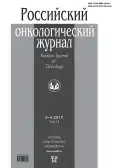Possibilities of differential diagnostics of histologicalforms of primary lung cancer with multi-spiral computed tomography based on artificial intelligence
- Authors: Borisenko O.V.1, Konovalov V.K.1, Lazarev A.F.1, Leonov S.L.2
-
Affiliations:
- Altai State Medical University
- Altai State Technical University
- Issue: Vol 24, No 3-6 (2019)
- Pages: 102-104
- Section: Basic Science - Practical Health Care
- URL: https://journals.rcsi.science/1028-9984/article/view/42478
- DOI: https://doi.org/10.18821/1028-9984-2019-24-3-6-102-104
- ID: 42478
Cite item
Full Text
Abstract
The problem of lung cancer, visualized including spherical formation of the lung, is becoming increasingly important every year. In the structure of the oncological morbidity of the Russian population among men in 2018, this pathology occupied the leading position – 16.9% (in women – 4.0%). When analyzing the distribution of patients with lung cancer of various age groups depending on the histotype of the tumor, it was found that in most cases it is adenocarcinoma and squamous lung cancer – 85%. MSCT was performed in 342 patients with spherical formation of the lung aged 45 to 80 years using computed tomographs Aquillion 64 and Asteion 4 (Toshiba Medical Systems). Digital analysis of scans was performed using the X-ray + program (Russia, Barnaul), which allows direct sampling of average pixel densities in a tabular form in selected areas of interest from DICOM files for subsequent analysis and statistical processing. The obtained densitometric indicators were received at the inputs of an artificial neural network. The effectiveness of differential diagnosis of histological forms: sensitivity – 35.7 + 2.6%, specificity – 40.6 + 2.6%, accuracy –76.3 + 2.3%.
Full Text
##article.viewOnOriginalSite##About the authors
O. V. Borisenko
Altai State Medical University
Author for correspondence.
Email: dr_borisenko.olga@mail.ru
postgraduate
Russian Federation, BarnaulV. K. Konovalov
Altai State Medical University
Email: dr_borisenko.olga@mail.ru
Russian Federation, Barnaul
A. F. Lazarev
Altai State Medical University
Email: dr_borisenko.olga@mail.ru
Russian Federation, Barnaul
S. L. Leonov
Altai State Technical University
Email: dr_borisenko.olga@mail.ru
Russian Federation, Barnaul
References
- Grigoryevskaya Z. V., Utkina V. L., Byakhova V. A. et al. Difficulties in the differential diagnosis of lung cancer and inflammatory changes in lung tissue. Siberian Oncology Journal. 2018; 17 (5): 119–24.
- Jemal A., Vines P., Bray F. et al. Atlas of modern oncology. Second Edition. Atlanta, Georgia: American Cancer Society. 2014. Access Mode: http://www.cancer.org/canceratlas.
- Kaprin A.D., Starinsky V.V., Petrova G.V., ed. Malignant neoplasms in Russia in 2018 (morbidity and mortality). M.: FGBU MNIII im. P.A. Herzen. 2019.250 p.
- Korolyuk I.P. Evidence-based radiology: basic principles and approaches to its implementation. Radiology-practice. 2007; 5: 7–21.
- Kosenok V.K., Belskaya L.V., Massard J. et al. Statistical patterns of the incidence of lung cancer in the Omsk region. Siberian Oncology Journal. 2016; 15 (4): 21–5.
- Merabishvili V.M. Medium-term variant forecast of mortality of the population of Russia from malignant neoplasms. Siberian Oncology Journal. 2019; 18 (4): 5–12.
- Merabishvili V.M., Arsenyev A.I., Tarkov S.A. et al. Morbidity and mortality from lung cancer, reliability of accounting. Siberian Oncology Journal. 2018; 17 (6): 15–26.
- Petrova G.V., Gretsova O.P., Starinsky V.V. Comparison of data from state oncological statistics and cancer register of Russia. Siberian Oncology Journal. 2019; 18 (5): 5–11.
- Recommendations for the early diagnosis of lung cancer for primary care physicians. Editorial. Bulletin of radiology and radiology. 2016; 97 (2): 69–78.
- Choynzonov E.L., Zhuikova L.D., Odintsova I.N. Mortality of the population of the Tomsk region from malignant neoplasms of the respiratory system. Siberian Oncology Journal. 2018; 17 (3): 5–10.
- Guldbrandt L. M., Fenger-Grøn M., Rasmussen T. R. et al. The effect of direct access to CT scan in early lung cancer detection: an unblinded, cluster-randomised trial. BMC Cancer. 2015; 15: 934.
Supplementary files







